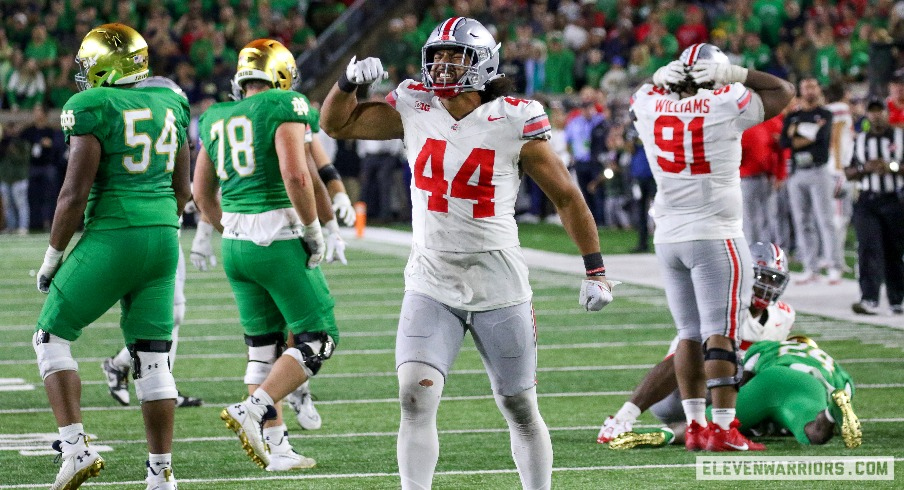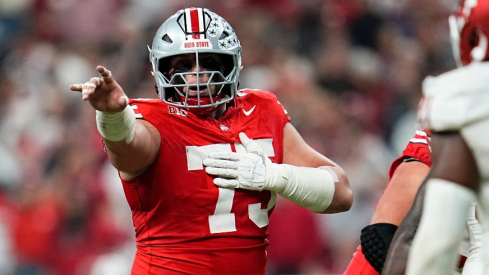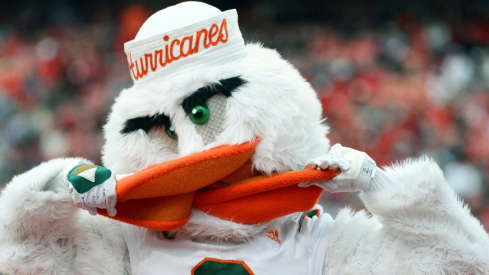Sacks aren’t a metric that is at the front of Jim Knowles’ mind. There are three metrics that bear particular importance to him in 2023.
“Everybody loves a lot of sacks,” Knowles said. “So do I. I think when I was younger I was probably driven more by that, ‘How can we get more sacks, more negative plays?’ But the bottom line is, eliminate the explosive plays, win on third and fourth down. So that’s what we’ve got to continue to focus on.”
That being noted, it is still shocking to see Ohio State’s top four defensive ends without a sack this season. As a team, the Buckeyes have only five sacks through four games.
But as the Buckeyes face an offense predicated on explosive plays from the arm of Taulia Tagovailoa, the pass rush should have opportunities to get home – though they’ll need to contain Maryland’s gunslinger.
“It’s got to be a coordinated rush, because you see multiple instances of guys coming free and then he makes them miss,” Knowles said. “So, really, there’s a lot of coordination involved in trying to contain him. It’s got to be a big part of the game plan.”
Despite not recording a sack against Notre Dame, Ohio State still found a way to get some pressure on Fighting Irish quarterback Sam Hartman against a top-tier tackle tandem of Joe Alt – an All-American last season – and Blake Fisher.
That after a game in which Jack Sawyer and JT Tuimoloau combined for 13 pressures alone against Western Kentucky. While it’s still an issue that the duo aren’t finishing those plays, the numbers still say they’re having an impact in pass rush.
“I thought we went against two really good tackles a couple of weeks ago,” Ryan Day said. “Watching that and evaluating that, I thought there were some good pass rushes in there. We were close. I think this week gives us an opportunity, again, to see where that goes.”
Tuimoloau and Sawyer played every single defensive snap against Notre Dame, 65 in total.
While there’s something to be said about keeping players fresh, Tuimoloau made his two biggest plays near the end of the game. He made a 5-yard tackle for loss, then broke up a screen pass on the next play, which led to a punt that got the ball back to Ohio State for its game-winning drive in South Bend.
“Those guys are becoming warriors,” Day said of Tuimoloau and Sawyer. “They’ve got to carry the water up front. That means taking on the majority of the body of work up there. The more we can get guys in there, the better off we can be in the long run, but I was proud of how many reps they played. It showed up though, because even on that last play, even though JT is in the whole game, you say, ‘He’s been playing a lot of football,’ he made two giant plays.”
Knowles said he’s “constantly weighing” his desire to rotate more players against sticking with what’s been working.
“It’s a tight game, it’s a matchup game,” Knowles said. “The plays, the way the game has changed, how many less plays, you just have more of an opportunity to let your best players play. Less substitution, in that case, it can be good to keep our guys in there. But it’s a balance. You always have to look at it.”
Tagovailoa presents a different threat than Ohio State’s defense has played this year, per Knowles, with his mobility allowing him to extend plays and find receivers downfield.
“It’s not like a typical quarterback where you say, ‘Hey, let’s present some different pictures, get him to hold the ball and just go after him,’” Knowles said. “You can’t do that with him, because if you present different pictures and he holds the ball, now you better be coordinated with your rush.”
“Those guys are becoming warriors. They’ve got to carry the water up front.”– Ryan Day on JT Tuimoloau and Jack Sawyer
It’s not that Tagovailoa presents a huge rushing threat, with 255 career rushing yards across 39 games. But when he gets out of the pocket, it’s often to create big plays for Maryland, who recorded seven plays that went 20 or more yards against Indiana in Week 5.
Five of those came from Tagavailoa’s arm. His first toss of the game was a 62-yard strike to Jeshaun Jones.
“We always talk about coverage and rush working together,” Knowles said. “He has the ability to extend plays. And when you get an extended play, the opportunity (for the offense) to make an explosive play, it goes up. He has that ability to extend it and I think that’s why it’s happening.”
There’s a mental focus required for the defensive line and secondary to stay disciplined on such plays as they go longer, Knowles added.
“I yell at them a lot (in practice) as the play goes on against the scout team,” Knowles said. laughing. “We have the quarterback try to extend plays to simulate it. Then I just scream at them as loudly as I can.”
Ohio State’s pass rush should get plenty of chances to both contain and take down Tagovailoa on Saturday. The Terrapins average 35.8 pass attempts per game, the 27th-most in the country. The question is whether the Buckeyes will be able to finish off its rushes with the sacks that have eluded them so far this season – or, at minimum, if they’ll be able to put enough pressure on Tagovailoa to keep him from getting into a rhythm.


